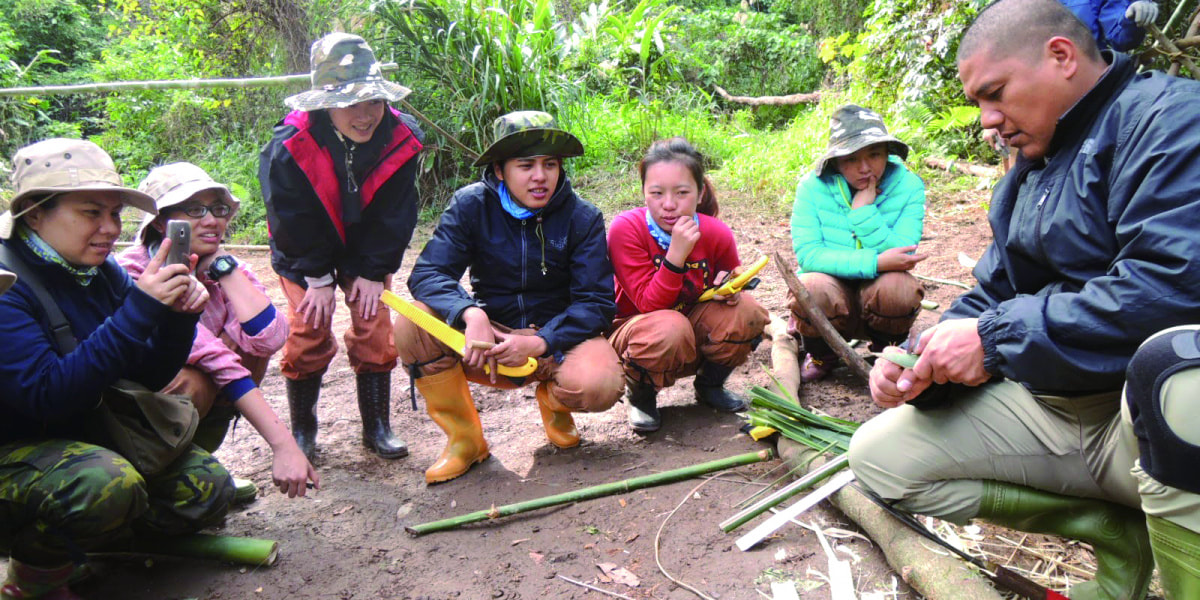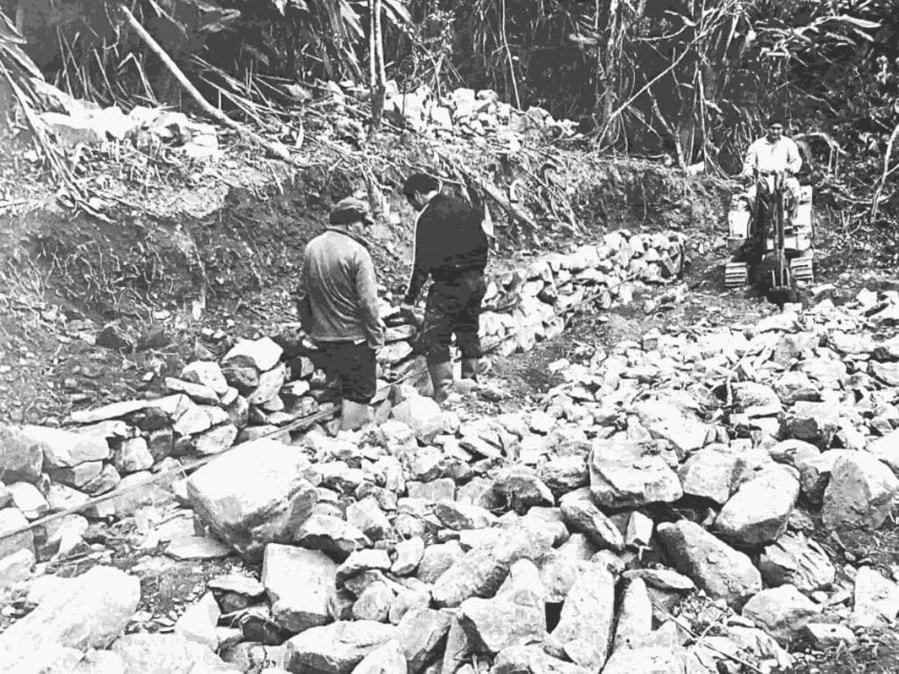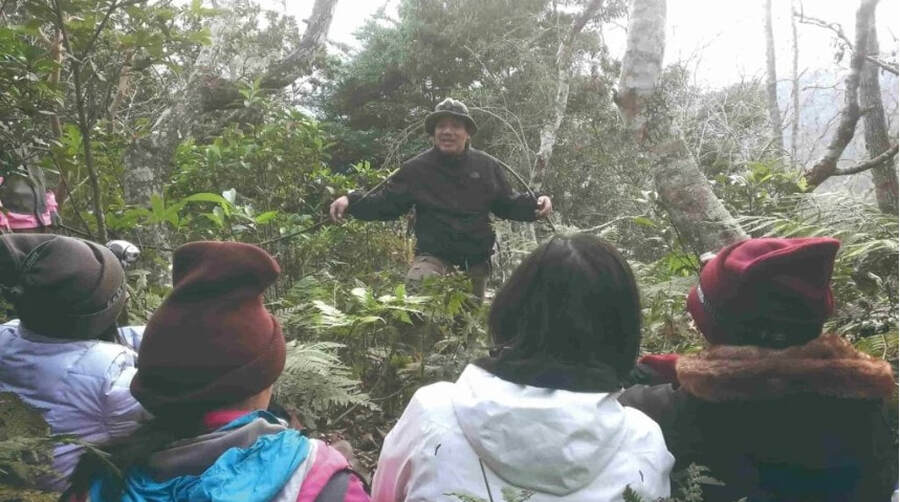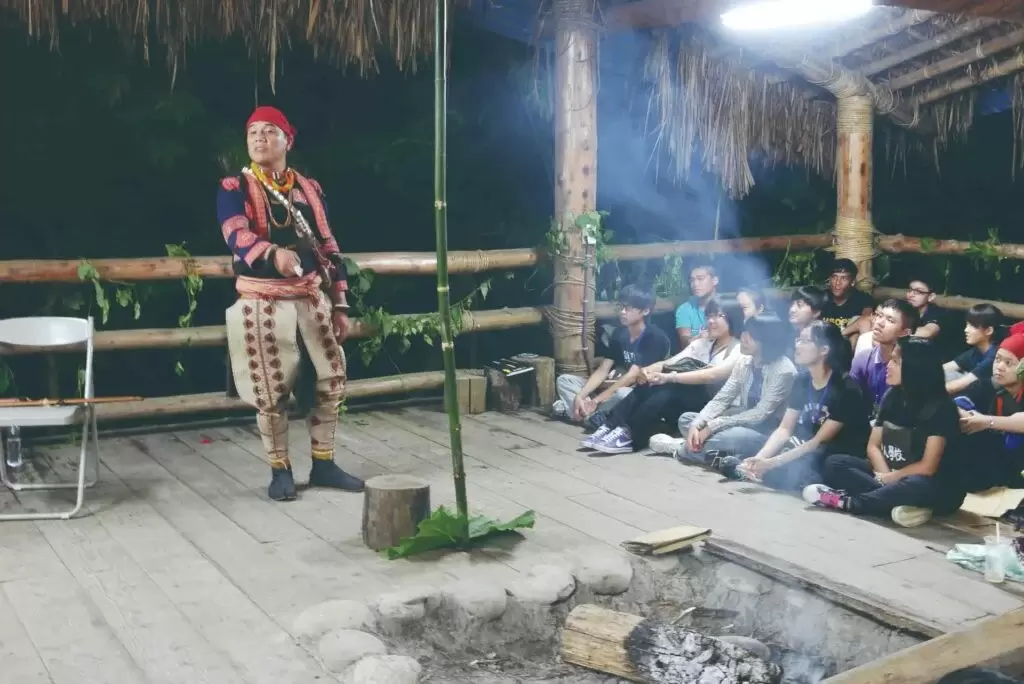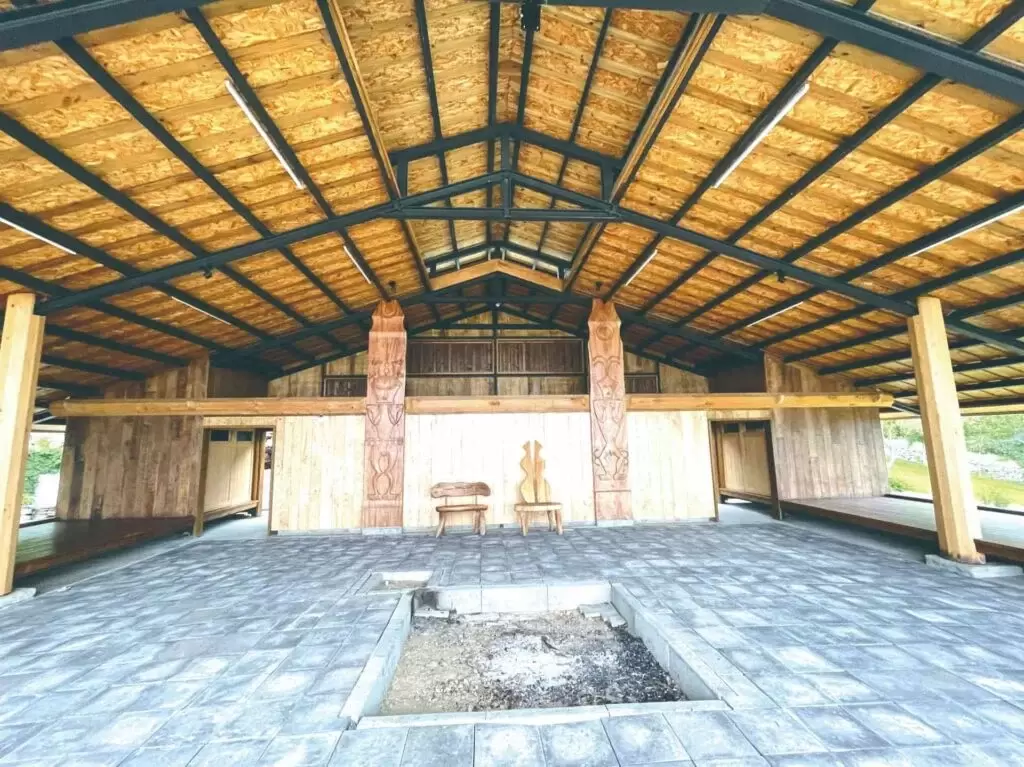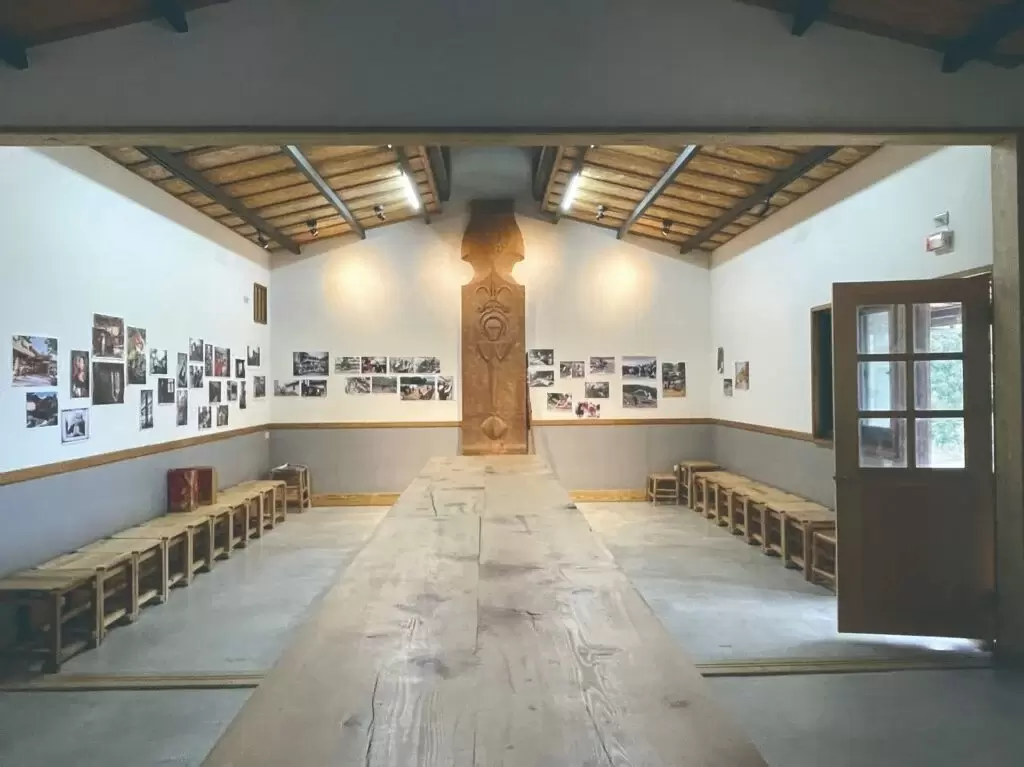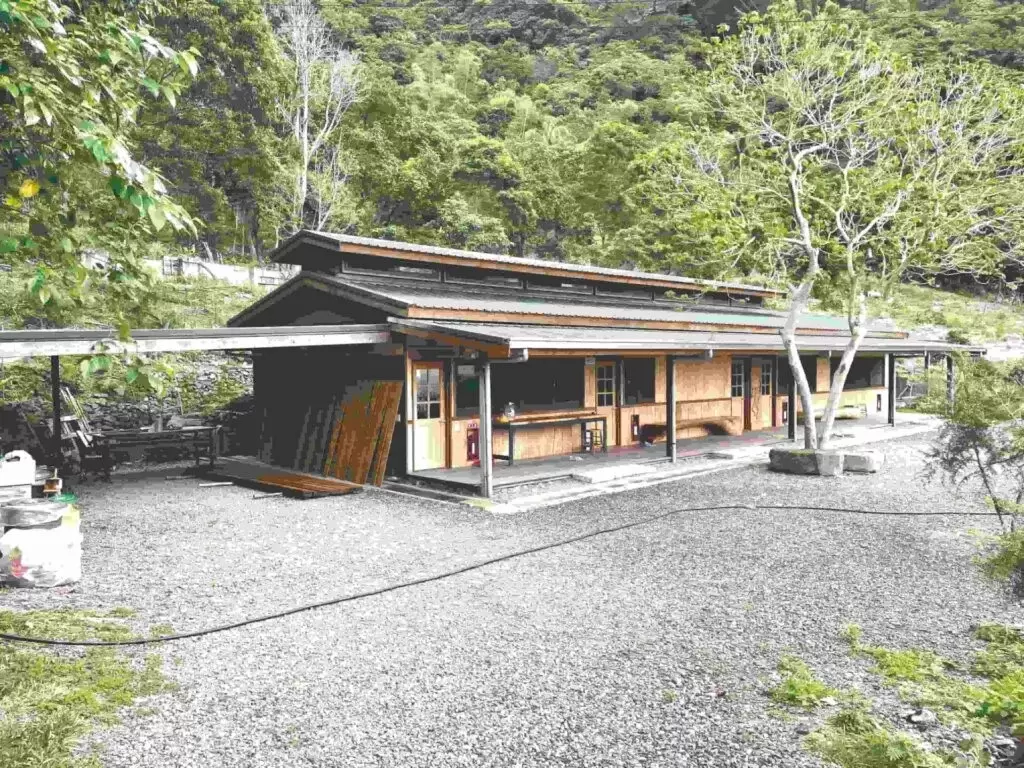"Dare to Dream, Hold On to Your Intention"
--- Sakinu Ahronglong, Founder of Hunter School
Passionate about preserving indigenous culture, Sakinu Ahronglong from the Paiwan tribe resigned from the Special Police First Headquarters in Taipei to return to his birthplace of Laulauran, Taitung in 2002 to pursue his dreams. From writing, giving speeches, working as a forest ranger to founding the Hunter School in 2002 and Cinunan Adventure Education in 2020, he hopes to bridge the lost connection between human and nature through these endeavors.
A Childhood Rooted in Tradition
With a strong build and tanned figure, Sakinu speaks with charisma reminiscent of the power of the mountains and the delicacy of water. His childhood nickname, “Liguchu,” which is Pinayuanan for “talkative” and “inquisitive,” shows how Sakinu was a curious child who wanted to try everything.
Raised by his grandparents, he credits his love of writing to his grandfather loves telling stories, while he inherits his acute insight from his grandmother. Though he developed a fondness for writing from a young age, his teachers would remark that his logic was spotty, critiquing him with the proverb, “you can’t make a silk purse out of a sow’s ear,” or “you can’t sculpt with rotten wood.” Sakinu would write in response, “but you can grow mushrooms from a sow’s ear and rotten wood!”
Looking back, Sakinu comments, “Luckily, my teacher couldn’t understand my writing, so I wasn’t corrected.” Growing up surrounded by tradition and culture, Sakinu retains his roots in his work, using his background to help inform the writing of his literature prize-winning novel. His successes show that what his teachers once thought was rotten wood actually had strong roots and branches, giving him a solid foundation for growth.
A Childhood Rooted in Tradition
With a strong build and tanned figure, Sakinu speaks with charisma reminiscent of the power of the mountains and the delicacy of water. His childhood nickname, “Liguchu,” which is Pinayuanan for “talkative” and “inquisitive,” shows how Sakinu was a curious child who wanted to try everything.
Raised by his grandparents, he credits his love of writing to his grandfather loves telling stories, while he inherits his acute insight from his grandmother. Though he developed a fondness for writing from a young age, his teachers would remark that his logic was spotty, critiquing him with the proverb, “you can’t make a silk purse out of a sow’s ear,” or “you can’t sculpt with rotten wood.” Sakinu would write in response, “but you can grow mushrooms from a sow’s ear and rotten wood!”
Looking back, Sakinu comments, “Luckily, my teacher couldn’t understand my writing, so I wasn’t corrected.” Growing up surrounded by tradition and culture, Sakinu retains his roots in his work, using his background to help inform the writing of his literature prize-winning novel. His successes show that what his teachers once thought was rotten wood actually had strong roots and branches, giving him a solid foundation for growth.
Nature is one of the many aspects Sakinu has found growth and inspiration from. His father, who is his hunting teacher, often tells Sakinu that “our land is borrowed from our children.” One time, when their neighbor cut down an old bishop wood tree, his father heart-rendingly asked the neighbor, “How could you sell our children’s shade?” Carrying on his father’s heart for the environment, Sakinu has planted over 120,000 trees on the land of the Hunter School over the years. On this, he says, “I’m giving the world an invisible present – the gift of fresh air.”
From a young age, Sakinu was well-grounded with the hunting culture of his ancestors. His father taught him the hunting wisdoms and values of their tribe. Later on, he carried on this respect for hunting by professionally training with the National Police Agency’s Special Police First Headquarters. It was there that he came to realization that not all hunters have the skills to pass on their experiences, and not all members of the Special Police First Headquarters value the spirit of hunting with some viewing it as murder or an environmental hazard. In effort to integrate these differences, Sakinu designed the classes at the Hunter School to focus on developing practical and culture-oriented hunting skills.
The first class, or “entering,” prepares students to enter the forest physically and mentally. The second class, or “follow,” teaches students to walk at a commutative pace, careful not to leave anyone behind. “Together,” or his third class, teaches students to safeguard one another, to protect themselves and each other. His fourth class, or “I can do it,” involves days of running and foresting in the woods to practice hunters’ gathering and chasing abilities. The last class, or “clarity,” allows students to enter the forest with the intention to nurture their connection with nature. Sakinu believes, “The purpose of the course is not solely to teach hunting skills, but to teach the true spirit and heart of hunting. They are designed for students to reconnect with nature.”
What motivates students to embark on this three-night four-day long trek, with its challenges of mountaineering, camping, cycling, and wading? From experience, Sakinu understands that extreme physical activity releases endorphins. This creates a situation where while a person's physical reserves are depleted, their mental state remains clearer than ever. Sakinu refers to this as the “peak experience,” which he hopes each of his students will be able to experience. He says, “This ‘peak experience’ of overcoming limitations is the spirit of a hunter.”
As a forest ranger, Sakinu occasionally is called to rescue lost or injured hikers. His peers often wonder where he finds the courage to surpass fear. He believes, “To overcome the fear of darkness, you must walk directly into the darkness.” He teaches students to walk in complete darkness, treating the night as a companion. He hopes for students to embrace their fears as an opportunity to face them.
Sakinu believes that forest education will help rebuild the relationship between human and nature. He hopes for people to connect with the phrase, “rain has emotion, trees can talk, and mountains have ears.” Being connected with nature is the basic ability for hunters to learn to listen and to wait.
The Hunter School classes were initially designed for young tribesmen. It was until Sakinu and his wife, Jane, had three daughters that she protested, “Girls should be allowed to experience the water, forest and darkness too!” Breaking tradition, he created the “Haohao Classroom of Women” to be able to pass on the wisdoms of hunting to his daughters and other women. When women are in the forest, he finds their bravery to be no different than men.
When it comes to the impact of Sakinu’s Hunter School, it is evident through the reflections of his students. Yichune from Taipei shares, “Knowing where to situate myself in the mountains to be in a position to help others is such a valuable ability.” Another student, Senayan, from the Papalu Pinuyumayan Community shares, “I am ever grateful for the unconventional women-focused hunting classes. Who knew how much work it would be to just learn to walk a mountain!” Lakuz from the Falangaw Amis Community shares, “Sakinu often says a mother is a child’s most important influence. He has taught me that if I want my child to be brave, I have to first become a brave mother!”
Nini from Tainan brings yet another story. Always wanting to get close to the mountains but not through leisure hiking, Nini found the Hunter School classes to be a perfect fit for her desire for challenge. She realized that anyone can use the sky for sight, the earth for bedding and trees for rest. “You don’t need an all-encompassing mountain gear to mountain climb, the mountain will tell you all of your needs.” she reflects. Bakkan from the Miharasi Truku Community in Hualien likewise has found strength that comes from conquering challenges with fellow women; as she says, “A gift and strength that no one can ever take away.” Eleng, who is a mix of Rukai and Paiwan, shares, “I’m already at the age where children call me Ina (aunt). Even though I don’t have experience being a mother, it’s my calling to support mothers and children.” While these women warriors have different personalities, they all hold the same air of determination, holding onto their inner understandings and convictions in the hunter culture.
From a young age, Sakinu was well-grounded with the hunting culture of his ancestors. His father taught him the hunting wisdoms and values of their tribe. Later on, he carried on this respect for hunting by professionally training with the National Police Agency’s Special Police First Headquarters. It was there that he came to realization that not all hunters have the skills to pass on their experiences, and not all members of the Special Police First Headquarters value the spirit of hunting with some viewing it as murder or an environmental hazard. In effort to integrate these differences, Sakinu designed the classes at the Hunter School to focus on developing practical and culture-oriented hunting skills.
The first class, or “entering,” prepares students to enter the forest physically and mentally. The second class, or “follow,” teaches students to walk at a commutative pace, careful not to leave anyone behind. “Together,” or his third class, teaches students to safeguard one another, to protect themselves and each other. His fourth class, or “I can do it,” involves days of running and foresting in the woods to practice hunters’ gathering and chasing abilities. The last class, or “clarity,” allows students to enter the forest with the intention to nurture their connection with nature. Sakinu believes, “The purpose of the course is not solely to teach hunting skills, but to teach the true spirit and heart of hunting. They are designed for students to reconnect with nature.”
What motivates students to embark on this three-night four-day long trek, with its challenges of mountaineering, camping, cycling, and wading? From experience, Sakinu understands that extreme physical activity releases endorphins. This creates a situation where while a person's physical reserves are depleted, their mental state remains clearer than ever. Sakinu refers to this as the “peak experience,” which he hopes each of his students will be able to experience. He says, “This ‘peak experience’ of overcoming limitations is the spirit of a hunter.”
As a forest ranger, Sakinu occasionally is called to rescue lost or injured hikers. His peers often wonder where he finds the courage to surpass fear. He believes, “To overcome the fear of darkness, you must walk directly into the darkness.” He teaches students to walk in complete darkness, treating the night as a companion. He hopes for students to embrace their fears as an opportunity to face them.
Sakinu believes that forest education will help rebuild the relationship between human and nature. He hopes for people to connect with the phrase, “rain has emotion, trees can talk, and mountains have ears.” Being connected with nature is the basic ability for hunters to learn to listen and to wait.
The Hunter School classes were initially designed for young tribesmen. It was until Sakinu and his wife, Jane, had three daughters that she protested, “Girls should be allowed to experience the water, forest and darkness too!” Breaking tradition, he created the “Haohao Classroom of Women” to be able to pass on the wisdoms of hunting to his daughters and other women. When women are in the forest, he finds their bravery to be no different than men.
When it comes to the impact of Sakinu’s Hunter School, it is evident through the reflections of his students. Yichune from Taipei shares, “Knowing where to situate myself in the mountains to be in a position to help others is such a valuable ability.” Another student, Senayan, from the Papalu Pinuyumayan Community shares, “I am ever grateful for the unconventional women-focused hunting classes. Who knew how much work it would be to just learn to walk a mountain!” Lakuz from the Falangaw Amis Community shares, “Sakinu often says a mother is a child’s most important influence. He has taught me that if I want my child to be brave, I have to first become a brave mother!”
Nini from Tainan brings yet another story. Always wanting to get close to the mountains but not through leisure hiking, Nini found the Hunter School classes to be a perfect fit for her desire for challenge. She realized that anyone can use the sky for sight, the earth for bedding and trees for rest. “You don’t need an all-encompassing mountain gear to mountain climb, the mountain will tell you all of your needs.” she reflects. Bakkan from the Miharasi Truku Community in Hualien likewise has found strength that comes from conquering challenges with fellow women; as she says, “A gift and strength that no one can ever take away.” Eleng, who is a mix of Rukai and Paiwan, shares, “I’m already at the age where children call me Ina (aunt). Even though I don’t have experience being a mother, it’s my calling to support mothers and children.” While these women warriors have different personalities, they all hold the same air of determination, holding onto their inner understandings and convictions in the hunter culture.
After returning to his home village from serving in the Special Police First Headquarters, Sakinu put all of his energy into the local youth village group. He opened his home to the village, and with the “Haohao Classroom of Women” next door, it seemed momentarily that all of Sakinu and his team’s hard work had come to life. In 2019, however, the night before Mother’s Day, disaster struck. A vicious fire destroyed Sakinu’s home and the “Haohao Classroom of Women”, it burned down the village’s longtime meeting place and a neighboring church. Sakinu not only had to pay for his own losses and for the renovations of the church, but was ordered to attend classes on fire damage and public danger laws. Making light of the situation, Sakinu joked that since there were so few people who were ordered to attend classes in Taitung for fire-related offenses, he had to take the classes with those there for drunk driving.
How do you rebuild after encountering such adversity? Jane reflects on the day of the fire where she received a phone call from her daughter saying that their home had caught fire – uncontrollable and widespread. “I let the pressure and worry go shortly after.” she said, and recalls having to console family members’ grief for the loss. The experience helped Jane let go of emotions both good and bad to start over. It gave her the realization that time waits for no one and that she must keep moving forward. She remembers a friend of her young daughter exclaiming, “You’ve burned all the housing, clothes, books and toys you’d ever want in your afterlife!” Jane, a resilient woman warrior, smiled with this comment.
As for Sakinu, after the incident, his daughters often found him by the sea, wistfully looking on with grave sorrow. Sakinu believes that the mother sea healed him from the trauma. Three months later, he told himself, “Sakinu, you are a man of passion, energy, and resilience; don’t be so easily defeated.”
Today, Sakinu is able to laugh about what his Paelabang Danapan teacher told him when he came to visit Sakinu long after the disaster. Teacher Danapang could only muster a stuttered comfort of, “Oh yes, indeed, this is a very large fire…oh, Sakinu, you must be the first aboriginal to have burned down a church…”
How do you rebuild after encountering such adversity? Jane reflects on the day of the fire where she received a phone call from her daughter saying that their home had caught fire – uncontrollable and widespread. “I let the pressure and worry go shortly after.” she said, and recalls having to console family members’ grief for the loss. The experience helped Jane let go of emotions both good and bad to start over. It gave her the realization that time waits for no one and that she must keep moving forward. She remembers a friend of her young daughter exclaiming, “You’ve burned all the housing, clothes, books and toys you’d ever want in your afterlife!” Jane, a resilient woman warrior, smiled with this comment.
As for Sakinu, after the incident, his daughters often found him by the sea, wistfully looking on with grave sorrow. Sakinu believes that the mother sea healed him from the trauma. Three months later, he told himself, “Sakinu, you are a man of passion, energy, and resilience; don’t be so easily defeated.”
Today, Sakinu is able to laugh about what his Paelabang Danapan teacher told him when he came to visit Sakinu long after the disaster. Teacher Danapang could only muster a stuttered comfort of, “Oh yes, indeed, this is a very large fire…oh, Sakinu, you must be the first aboriginal to have burned down a church…”
Sakinu started rebuilding his village, remounding his mountain and preparing his classrooms and structures. Though he wished for his daughters’ help, he failed to consider that as the girls grow older, they no longer want to follow their father’s way. Jane talks of her daughter’s sentiment of feeling wronged, “Over the New Years, while others were celebrating with fireworks. Our daughters were celebrating by clearing the rocks up the mountain hills.” This tension lasted for about a year until Sakinu held a family meeting, openly expressing each other’s thoughts and emotions. Sakinu apologized to his daughters, starting the practice of setting dates to spend time with them such as having lunch together when his oldest daughter ends the school day, organizing a two-day one-night nature trip with his second daughter, or riding bikes with his youngest daughter. Finding himself through adversity helped his family move forward with their journey.
The fire incident also burned off some old habits. Before, Sakinu held onto an “if I won’t do it, no one will” attitude towards his village work. Now, he is able to delegate and retire from his leadership roles in the Tribal Traditional Youth Union, recognizing that by letting go of his own will, he may be able to achieve more altogether. Finally rebuilt, the new Hunter School is noticeable from any angle, whether from the hills or the woods. Sakinu credits its perfect proportions and details to Jane who used to work in an architect’s office and has a natural eye for aesthetics and construction. She taught Sakinu how to design a blueprint, meticulously planning out every room, door, and window measurement – even so far as to the space needed to walk from the kitchen to the bathroom. With her caution and attentiveness to detail, they hope to find the right placement in the forest for their new house. When it comes to visuals, the couple took care in designing a minimalist look adding important traditional aboriginal elements within as finishing touches but also allowing cultural freedom for modern expression.
Sakinu’s new home has also been inspired by the essence of his travels. Some such inspirations are Japanese interior architectural structure, traditional Filipino balconies, the Sami people in Norway’s cultural preservation habitats, etc. In particular, his archery classroom’s ventilation system was inspired by a time when Sakinu chased a criminal to a pig pen. At that time, he noticed how the roof’s ventilation system was well-designed and thought out, giving Sakinu inspiration for his future constructions.
The fire incident also burned off some old habits. Before, Sakinu held onto an “if I won’t do it, no one will” attitude towards his village work. Now, he is able to delegate and retire from his leadership roles in the Tribal Traditional Youth Union, recognizing that by letting go of his own will, he may be able to achieve more altogether. Finally rebuilt, the new Hunter School is noticeable from any angle, whether from the hills or the woods. Sakinu credits its perfect proportions and details to Jane who used to work in an architect’s office and has a natural eye for aesthetics and construction. She taught Sakinu how to design a blueprint, meticulously planning out every room, door, and window measurement – even so far as to the space needed to walk from the kitchen to the bathroom. With her caution and attentiveness to detail, they hope to find the right placement in the forest for their new house. When it comes to visuals, the couple took care in designing a minimalist look adding important traditional aboriginal elements within as finishing touches but also allowing cultural freedom for modern expression.
Sakinu’s new home has also been inspired by the essence of his travels. Some such inspirations are Japanese interior architectural structure, traditional Filipino balconies, the Sami people in Norway’s cultural preservation habitats, etc. In particular, his archery classroom’s ventilation system was inspired by a time when Sakinu chased a criminal to a pig pen. At that time, he noticed how the roof’s ventilation system was well-designed and thought out, giving Sakinu inspiration for his future constructions.
Reusing and resaving is an important part to helping the environment. Everything is connected with the soil, even lost branches thrown on the roadside can become important construction material or fertilizer. “We must turn the best life experiences we’ve had into the best qualities we can share.” Some people have questioned Sakinu’s construction and deviation from traditional architectural methods. To this, he says somewhat revolutionarily, “Too many rules will stop me from what I dream of doing.”
Due to the fire, Sakinu’s house must be built on unconventional grounds, breaking the barriers of what he once thought he knew. "Without boundaries," Sakinu says with pride, “now I can truly build a house atop a slope."
Three years after the fire, there is much to rebuild, but under Sakinu's unwavering belief, the rebuilding process has gone much faster than expected. One aspect to be curious about is – how has he found the people and money necessary to fund his project? Sakinu answers this question with yet another question, “If we were living in the Holocaust, who do you think would help you? The people you've helped before, or those who have always been helping you? I thought that it would be the people who you've helped before who would repay your kindness.” Sakinu laughed at this naivete. He now knows the answer is the latter, “Those who are helping you already have kindness built in them; those who you have helped may not have this trait yet and may not likewise return the favor.”
When it comes to funding projects, Jane talks about a friend who is passionate about triathlons. He made it so that if any Hunter School students attend and complete a triathlon, they will receive a reward of NT$50,000. Jane recollects everyone's motivation, recalling, "People started learning how to swim and those who didn't cycle fast quickly practiced cycling faster.." In the end, around 50 students were able to complete a triathlon, earning over NT$2 million. This became the first founding money for the gathering place of the Hunter School.
As for the archery classroom, the funding for the program came from a fellow archer and friend in Hong kong. Sakinu reached out, claiming, "I believe my project is worth joining. I am inviting you to join not for you to help me, but to endeavor this education project together." Both carrying the same dreams, the two ended up walking along the same path, still together, side by side.
To go where no one has been before is a path bound to be met by external doubt, rejection, and jealousy; however, nothing compares to the weighty obstacle of self-doubt. He says, "Aboriginal people are not worse off than others; they just don't have money." However, not having money doesn't always signify poverty. In his book, Sakinu writes, "The country took away my ancestors’ forests, hunting grounds, and fields, but they cannot take away my two feet. I can go wherever I want to go, which makes me the richest man in the world."
Due to the fire, Sakinu’s house must be built on unconventional grounds, breaking the barriers of what he once thought he knew. "Without boundaries," Sakinu says with pride, “now I can truly build a house atop a slope."
Three years after the fire, there is much to rebuild, but under Sakinu's unwavering belief, the rebuilding process has gone much faster than expected. One aspect to be curious about is – how has he found the people and money necessary to fund his project? Sakinu answers this question with yet another question, “If we were living in the Holocaust, who do you think would help you? The people you've helped before, or those who have always been helping you? I thought that it would be the people who you've helped before who would repay your kindness.” Sakinu laughed at this naivete. He now knows the answer is the latter, “Those who are helping you already have kindness built in them; those who you have helped may not have this trait yet and may not likewise return the favor.”
When it comes to funding projects, Jane talks about a friend who is passionate about triathlons. He made it so that if any Hunter School students attend and complete a triathlon, they will receive a reward of NT$50,000. Jane recollects everyone's motivation, recalling, "People started learning how to swim and those who didn't cycle fast quickly practiced cycling faster.." In the end, around 50 students were able to complete a triathlon, earning over NT$2 million. This became the first founding money for the gathering place of the Hunter School.
As for the archery classroom, the funding for the program came from a fellow archer and friend in Hong kong. Sakinu reached out, claiming, "I believe my project is worth joining. I am inviting you to join not for you to help me, but to endeavor this education project together." Both carrying the same dreams, the two ended up walking along the same path, still together, side by side.
To go where no one has been before is a path bound to be met by external doubt, rejection, and jealousy; however, nothing compares to the weighty obstacle of self-doubt. He says, "Aboriginal people are not worse off than others; they just don't have money." However, not having money doesn't always signify poverty. In his book, Sakinu writes, "The country took away my ancestors’ forests, hunting grounds, and fields, but they cannot take away my two feet. I can go wherever I want to go, which makes me the richest man in the world."
Hunter School
The Hunter School will soon open its doors to nearby schools, allowing nearby village children to experience its adventure and wonder. The program offers itself not on a tourist ban, but on a limited educational visitational exchange. Welcoming other exchanges, Sakinu says, "The Hunter School isn't just for the Paiwan Lalauran village. As long as you want to learn about the wisdom of the forest, no matter your gender or race, you are welcome here."
Sakinu compares education to a plant needing a goal to reach; like how plants strive towards the sun, education must strive towards greatness. He believes that the best education doesn't just involve passing on and reviving the Paiwan culture, rather, he believes the power of education to be far greater, able to push past the current shapes and limits of tradition like how plants sprout from soil.
To Sakinu, "Changing tradition is actually just continuing tradition." Preserving a culture is a road heavy with responsibility, but it is a part Sakinu accepts. He says, "Being able to all be a family, whether related by blood or not... this is what I want for the future Hunter School." This fostering of community has been long written in Sakinu's hunting notebook, showing his long time dedication to the belief.
During the interview period, every morning, I saw Sakinu busy pulling weeds, planting seeds, moving bricks, and building the house. All moving towards his goal, his strong companion, Jane, tells me, "There is a giant that lives inside Sakinu's heart."
Like a giant, Sakinu's gaze is large enough to see the seas and mountains and still, dare to dream and remember why he started.
The Hunter School will soon open its doors to nearby schools, allowing nearby village children to experience its adventure and wonder. The program offers itself not on a tourist ban, but on a limited educational visitational exchange. Welcoming other exchanges, Sakinu says, "The Hunter School isn't just for the Paiwan Lalauran village. As long as you want to learn about the wisdom of the forest, no matter your gender or race, you are welcome here."
Sakinu compares education to a plant needing a goal to reach; like how plants strive towards the sun, education must strive towards greatness. He believes that the best education doesn't just involve passing on and reviving the Paiwan culture, rather, he believes the power of education to be far greater, able to push past the current shapes and limits of tradition like how plants sprout from soil.
To Sakinu, "Changing tradition is actually just continuing tradition." Preserving a culture is a road heavy with responsibility, but it is a part Sakinu accepts. He says, "Being able to all be a family, whether related by blood or not... this is what I want for the future Hunter School." This fostering of community has been long written in Sakinu's hunting notebook, showing his long time dedication to the belief.
During the interview period, every morning, I saw Sakinu busy pulling weeds, planting seeds, moving bricks, and building the house. All moving towards his goal, his strong companion, Jane, tells me, "There is a giant that lives inside Sakinu's heart."
Like a giant, Sakinu's gaze is large enough to see the seas and mountains and still, dare to dream and remember why he started.
The article is featured in Humanistic Education Foundation, written by Momo Hsu and translated to English by ACF volunteer Gloria Jen.

